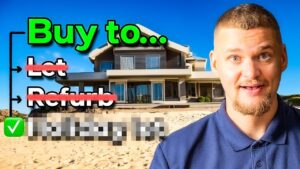In a recent YouTube video, we took a sneak peek inside my £4,000,000 Mansion in our latest house tour! We won't be at this property for much longer, so I thought why not show you guys around before we begin renting our next second home!
We have two homes because of the number of events, trainings, meet ups, parties, etc. that we run for the business. This allows us to have a house that is more a family space and one that is good for socialising, entertaining and business. This level of separation is great for us as a family and allows us to have the best of both worlds.
It is important to understand that all this is paid for from the passive income from our property business. Before deciding to buy any luxury, make sure that your passive income can pay for it. If it can’t, keep investing your active income until it can. In this article, I will give you a three-step plan for generating passive income in property.
1. Rent to rent and deal sourcing
The first thing you need to do is to get an active property income. Two great options to become a property entrepreneur are rent to rent and deal sourcing. Rent to rent is where you take on a property on a long-term contract and then rent it out for more either by renting it by the room or renting the property as a holiday let. Deal sourcing is where you find and negotiate property deals, and then pass those deals to investors for a fee.
Both of these options are a great way to start making money in property; however, both are active income. You will need to work in the business finding and selling deals and, although the income is recurring in rent to rent, there will be a level of management needed. You will also need to find new rent to rent deals from time to time as contracts end.
2. Buy, refurbish, refinance, rent
If you have done step one correctly, you should now have cash coming in from your active property business. This is not the time to go and splash out. Keep your expenditure to a minimum at this point. Use any money coming in to save for a deposit.
Use this saved money to buy a property which is in bad condition that you can add value to. Use a bridging loan to cover the rest. Make sure that once the property is done up 75% of the new value will equal or exceed the amount spent on the purchase and refurbishment. Then get a regular 75% buy-to-let mortgage and get all your cash back! Use that cash to do it all again on another property. This is known as buy, refurbish, refinance, rent.
3. Hire your replacements
You now have passive income from the rental of the properties you own, but there will still be some level of ‘managing the managers’ involved. Once your passive income is reasonably substantial from your properties, you need to find your replacement. Hire someone that can be in contact with the letting agents and deal with any issue that comes up.
Also, find people to replace you in the active property business. Find people that can do each role and then leave them to do it. Create an editable training manual and update it every time an employee needs help. Even if your employee leaves, all the information will be in the manual. Once you no longer need to be part of the business, you can keep the company as a source of passive income or sell it for multiple times earnings.




